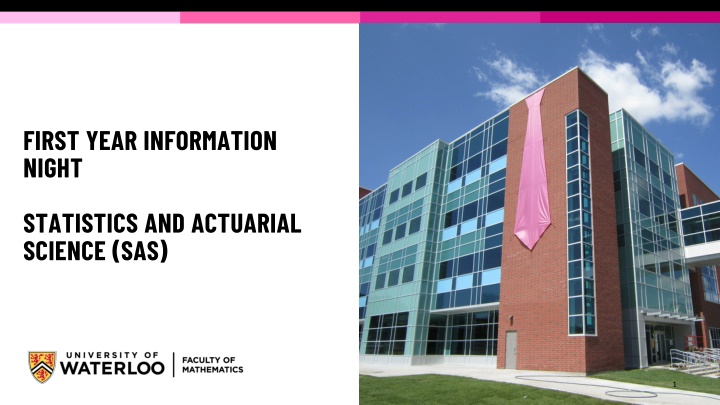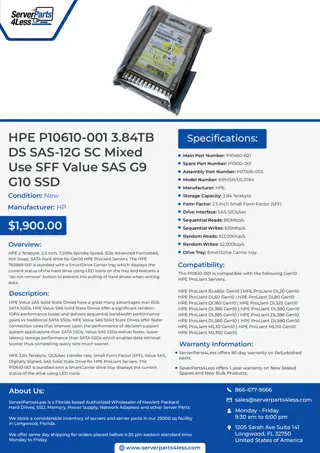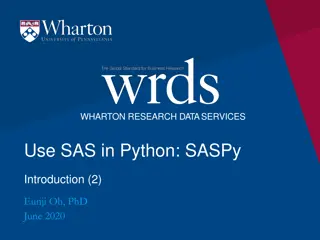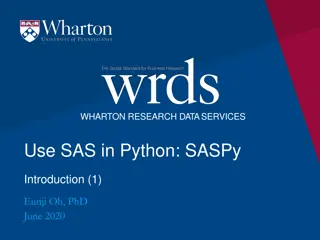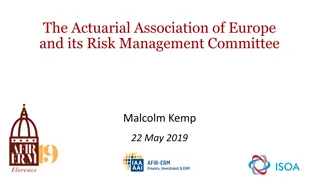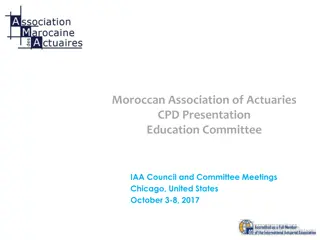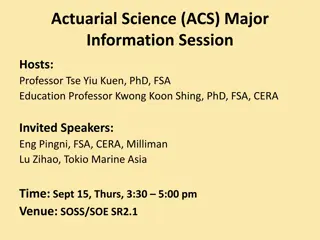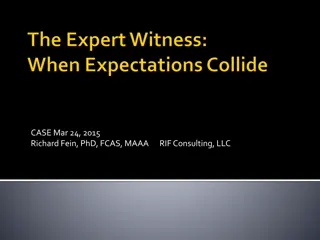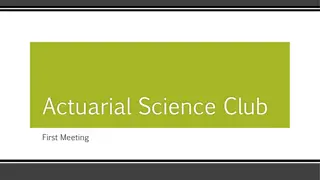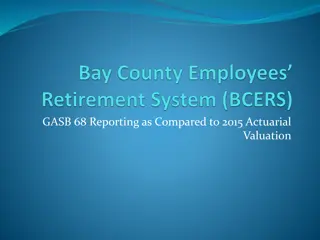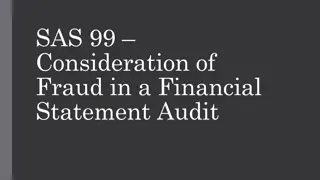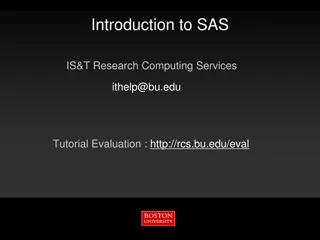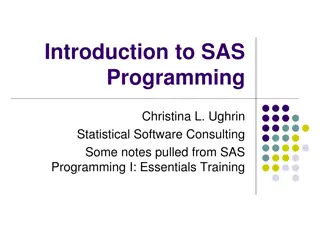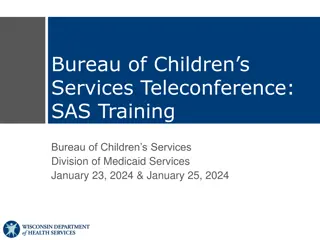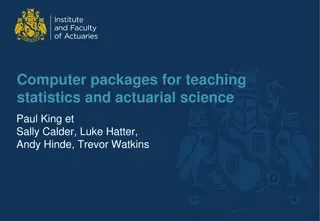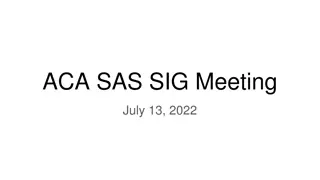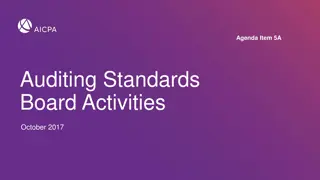First Year Information Night for Statistics and Actuarial Science (SAS)
Meet your Statistics and Actuarial Science advisors - Emily Kozlowski and Riley Metzger. Learn about the roles of advisors in signing course override forms, plan modification forms, and providing program-related guidance. Find out how to get help from an advisor and explore the field of Statistics. Admission requirements and courses for 1A/1B are also discussed.
Download Presentation

Please find below an Image/Link to download the presentation.
The content on the website is provided AS IS for your information and personal use only. It may not be sold, licensed, or shared on other websites without obtaining consent from the author.If you encounter any issues during the download, it is possible that the publisher has removed the file from their server.
You are allowed to download the files provided on this website for personal or commercial use, subject to the condition that they are used lawfully. All files are the property of their respective owners.
The content on the website is provided AS IS for your information and personal use only. It may not be sold, licensed, or shared on other websites without obtaining consent from the author.
E N D
Presentation Transcript
FIRST YEAR INFORMATION NIGHT STATISTICS AND ACTUARIAL SCIENCE (SAS) 1
Meet (some of) your Statistics and Actuarial Science Advisors Emily Kozlowski Continuing Lecturer, Head ActSci advisor, Waterloo alumni, twice (BMath & MMath), in Actuarial Science, and an associate in the SOA & CIA. Riley Metzger Continuing Lecturer, Head Stat advisor, and Waterloo alumni, twice (BMath & MMath), in Statistics. PAGE 2
What do the advisors do? Sign course (selection) override forms for all STAT and ACTSC courses (also MTHEL 131 and ENGL 378). Sign plan modification forms (used to declare majors/joints/minors/specializations) for all ACTSC and STAT plans. Answer questions about courses in ACTSC and STAT. Things like pre-req or anti- req questions, substitutions, offerings, order to complete them and so on. Answer questions about the programs in ACTSC and STAT, such as electives needed, average to maintain, average calculation, how to do a double major or a minor with it. Many, many more things! PAGE 3
How do I get help from an advisor? First check the FAQ and Table of Questions pages on the department website. If you can t find your question, then you can either email the advisors at SASUGradAdv@uwaterloo.ca or visit us (in-person or virtually) during our regular advising hours. Hours are posted on the department website. FAQ Tables of Questions Advising hours PAGE 4
STATISTICS PAGE 5
Statistics The field of drawing reliable conclusions from data. Example Questions: How do governments and businesses come up with their conclusions about the population or the economy? How does a company know their marketing campaign has been successful? In manufacturing, what s the appropriate amount of defects to have from one machine?
Admission requirements All our plans are 2A entry, i.e. you need to have passed a minimum of 10 courses. Statistics Cumulative average (CAV) of 60%+ and math average (MAV) of 65%+ No limit to number of students PAGE 7
1A/1B Courses - STATISTICS Fall CS 115/135 MATH 135 MATH 137 Communication List 1 Course Winter CS 116/136 MATH 136 MATH 138 STAT 230 (if you have 80 or more in MATH 137) or a Non Math Elective Non Math Elective Non Math Elective *This is the standard sequence for math students. If you are having difficulties or you are excelling there are alternative sequences. Please contact a year 1 math advisor to find out more: MathAdvisors@uwaterloo.ca. PAGE 8
Suggested Non Math Courses For statistics you have a minimum of 26 math courses 10 non math courses 4 courses that can be anything 2 of the non math courses are communication courses. However the other 8 can be: Courses that will help you complete a minor in another field: Economics, Psychology, Physics etc. Courses that you find interesting PAGE 9
BIOSTATISTICS PAGE 10
Biostatistics The field of drawing reliable conclusions from data in the life sciences. Bio- Stats Statistics Life Sciences Example Questions: Does a particular vaccine reduce the likelihood of getting COVID? What affect does a government policy have on the proportion of smokers? What is the home range of a bear?
Admission requirements All our plans are 2A entry, i.e. you need to have passed a minimum of 10 courses. Biostatistics Cumulative average (CAV) of 60%+ and math average (MAV) of 65%+ No limit to number of students PAGE 12
1A/1B Courses - BIOSTATISTICS Fall CS 115/135 MATH 135 MATH 137 Communication List 1 Course Winter CS 116/136 MATH 136 MATH 138 STAT 230 (if you have 80 or more in MATH 137) or a Non Math Elective Non Math Elective Non Math Elective *This is the standard sequence for math students. If you are having difficulties or you are excelling there are alternative sequences. Please contact a year 1 math advisor to find out more: MathAdvisors@uwaterloo.ca. PAGE 13
Suggested Non Math Courses For biostatistics you have a minimum of 26 math courses 10 non math courses 4 courses that can be anything 2 of the non math courses are communication courses. 1 of the non math courses is either BIOL 239 or HLTH 101. However the other 7 can be: Courses that will help you complete a minor in another field: Economics, Psychology, Physics etc. Courses that you find interesting PAGE 14
SOME OF YOUR (BIO) STATISTICS QUESTIONS What is the difference between biostatistics and bioinformatics? 1. 2. What are the major differences between Statistics and Biostatistics? 3. What are the issues with a double degree student wanting STATs/BioSTATs? PRESENTATION TITLE PAGE 15
SOME OF YOUR (BIO) STATISTICS QUESTIONS 4. What joints/majors can you combine with Statistics? 5. What joints/majors can you combine with BIOstatistics? 6. What courses cover data science material such as ML and AI? 7. Why might someone not like Statistics, Biostatistics, or Data Science? PRESENTATION TITLE PAGE 16
SOME OF YOUR (BIO) STATISTICS QUESTIONS 8. What are the employable/in demand skills in statistics? 9. Is a PhD necessary for Statistics/Biostatistics/Data Science? PRESENTATION TITLE PAGE 17
DATA SCIENCE PAGE 18
Data Science The field of drawing reliable conclusions from large data sets. It studies things such as AI, Data Science and Machine Learning. Computer Science Statistics Example Questions: Spam filtering: How to classify emails as spam versus legitimate Computer Vision: recognize objects in images and videos Speech Recognition: recognize words from an audio signal Conversational Agents: learn how to respond to user queries
BMath Data Science FAQs: BCS vs BMATH How is BMath Data Science different from BCS Data Science? BCS student is a CS major with some Statistics, and as such has access to any CS course. BMathDS is a Statistics degree with added CS. It does not let you into any CS course, but restricts you to the list of available courses. BCS has a depth and breadth requirement. BMath does not. BCS allows you any communication list 2 course. BMath restricts your communication list 2 course to ENGL 378. PAGE 20
Admission requirements All our plans are 2A entry, i.e. you need to have passed a minimum of 10 courses. BMath Data Science MAV of 65%+, CS average of 70%+, completed or taking CS 136 Competitive entry (~16 per term = 50 per year) meaning the acceptance cut-offs above depend on the students who apply that term PAGE 21
BMath Data Science FAQs: APPLICATIONS Applications When do you apply? Are you taking CS 136 or have you already passed it? Will you have 10 passed courses by the end of term? Are you currently in lectures? Then you can apply by filling out our online form. It is really quick and only requires you to give your name and IDs. When can you not apply? If you do not have CS 136 OR it is during our black out period (from the end of lectures until results are communicated to applicants). When do you learn your results? In the first month of the NEXT term. This may be after the add period of courses. Application Received During Lecture Period Fall Term Winter Term Spring Term Results Communicated to Applicants By end of Jan By end of May By end of Sept PAGE 22
BMath Data Science FAQs: ADMISSION AVERAGES What was the latest admission averages? Each term the admission averages differ as the plan is competitive. We look at 3 averages on a minimum of 10 courses: CAV (cumulative or overall average). This is the average of every course you take that has a numeric grade. Math MAV (Math major average). This is all of your courses offered by the faculty including CS 115, MATH 135, MATH 137, etc. CS MAV (CS major average). This does not include any course below CS 136. Nor does it include non CS major courses such as CS 231. This past Sept the CAV was at least 86 for incoming students. We then wanted the other two averages to be high . PAGE 23
BMath Data Science FAQs: NOT ACCEPTED? I didn t get in, can I apply again? Yes, you can apply again, however it would be wise to have a back-up plan in place. Other Suggestions? An alternative might be a Statistics Major with a Computing Minor. Aim to take CS 431. Another alternative might be computational math major with a concentration on Statistics and a computing minor. PAGE 24
BMath Data Science FAQs: NOT ACCEPTED? Can I take less than 5 courses a term and still get into Data Science? Can I WD a course(s)? Yes you can. However we will not accept you into the program until you have at least 10 passed courses. Can I retake courses to increase my grade? Yes. However I do not recommend it. Why? Both the original course and retaken course will be on your record. Both courses go into your average with equal weighting. 1. 2. You are allowed at most 3 attempts at any course. 3. You will accumulate an unusable attempt. You are allowed a maximum of 10 of these. PAGE 25
1A/1B Courses BMath Data Science Fall CS 115/135 MATH 135 MATH 137 Communication List 1 Course Winter CS 116/136 MATH 136 MATH 138 STAT 230 (if you have 80 or more in MATH 137) or a Non Math Elective Non Math Elective Non Math Elective *This is the standard sequence for math students. If you are having difficulties or you are excelling there are alternative sequences. Please contact a year 1 math advisor to find out more: MathAdvisors@uwaterloo.ca. PAGE 26
Suggested Non Math Courses For data science you have a minimum of 29.5 math courses 10 non math courses 0.5 courses that can be anything 2 of the non math courses are communication courses. However the other 8 can be: Courses that will help you complete a minor in another field: Economics, Psychology, Physics etc. Courses that you find interesting PAGE 27
What courses should I watch out for? ENGL 378 requires 70+% in your first communication course (EMLS 101R, 102R, EMLS/ENGL 129R, ENGL 109, COMMST 100, 223) STAT 330, 333, 340, 341 requires 60+% in STAT 230 STAT 331, 332 requires 60+% in STAT 231 PAGE 28
ACTUARIAL SCIENCE PAGE 29
What is Actuarial Science? Actuaries are business professionals who apply their knowledge of mathematics particularly of probability, statistics, and risk theory to real-life financial problems involving future uncertainty. Actuaries work in: Insurance Companies (Life and P&C) Consulting Firms Investment Banks Governments Regulatory/Financial Oversight Organizations Any company with large volumes of data / financial uncertainties / a desire to manage their risk and capitalize on insights from big data PAGE 30
How Do I Become an Actuary? Unlike data scientists or statisticians, actuaries hold professional designations based on the organization they belong to and their status in the professional examination system. Some of the professional actuarial organizations are: Society of Actuaries, SOA (www.soa.org), Canadian Institute of Actuaries, CIA (www.actuaries.ca), Casualty Actuarial Society, CAS (www.casact.org) Institute and Faculty of Actuaries, IFoA (www.actuaries.org.uk) Students who study Actuarial Science at Waterloo are well on their way to earning associate level designations by the time they graduate. PAGE 31
Admission requirements All our plans are 2A entry, i.e. you need to have passed a minimum of 10 courses. To declare Actuarial Science as a major, joint, or minor, students are required to have: Completed MTHEL131 with a minimum grade of 60.0%; or, for Business Administration and Mathematics Double degree students, a minimum grade of C- in BUS121W. A minimum special major average of 70.0%; or if a SMAV does not yet exist A minimum cumulative average of 70.0% on at least 10 courses, and no failed courses (i.e. no < 50 or DNW or WF). ACTSC SMAV exists once you have 3 courses from: STAT 230/231, ACTSC 231/232, any 300-400 level math courses No limit to number of students PAGE 32
What is MTHEL 131? Introduction to Actuarial Practice Individual life insurance products. Introduction to property and casualty insurance. Introductory risk management, insurance pricing and valuation. Pension plan design. A broad overview of the actuarial industry without all the math. The course is offered both fall and winter terms, so if you aren t in it now, make sure you sign up for it in Winter, otherwise you won t be able to declare Actuarial Science in 2A. PAGE 33
What if I want to declare BOTH ActSci and Stats? To declare a double major in Actuarial Science and Statistics you need to have: a CAV of 70+% (or SMAV of 70%+) a MAV 65+% (normally satisfied with SMAV of 70%+) completed 10 courses (no fails in first year if SMAV can t be calculated yet) completed MTHEL 131 with 60%+ To complete the double major you need to meet all the specific Actuarial Science course requirements PLUS STAT 332 (counted in the one additional 300 or 400 math requirement), and 3* 400-level Statistics courses. *only 1 if you take two of STAT 431/433/441/443 in the ACTSC additional list. PAGE 34
1A/1B Courses Actuarial Science Fall CS 115/135 MATH 135 MATH 137 Communication List 1 Course MTHEL 131 Winter CS 116/136 MATH 136 MATH 138 ECON 101 AFM 101 (MTHEL 131 if not taken in 1A) *There is flexibility when you take ECON 101/102, AFM 101 and the rest of the non-math electives. The most important thing is taking MTHEL 131 in your first year if you want to get into ActSci at the start of year 2. PAGE 35
2A/2B Courses Actuarial Science Fall STAT 230 MATH 235 MATH 237 ACTSC 231 ECON 102 Winter Stat 231 ACTSC 232 ACTSC 372 Elective or AMATH 250 Elective *All of ACTSC 231, 232, and 372 open to any math student, other ACTSC 3XX and 4XX only open to ACTSC majors PAGE 36
Suggested Non-Math Courses For actuarial science you have a minimum of 27 math courses 10 non math courses 3 courses that can be anything 2 of the non math courses are communication courses. Another 4 of the non math courses are ECON 101/102, AFM 101, MTHEL 131. However, the other 4 can be: Courses that will help you complete a minor in another field: Economics, Psychology, Physics etc. Courses that you find interesting PAGE 37
Adding the Predictive Analytics Specialization to ACTSC As of the 2023/2024 calendar, to complete Honours Actuarial Science with the Predictive Analytics specialization you must complete the Honours Actuarial Science plan plus the following: 1 of ACTSC 454 or STAT 437 ACTSC 454 will count for the One additional 400- level ACTSC courses . 1 of STAT 440 or STAT 442 will count as the One additional 300- level or 400- level math course . All of CS 330, STAT 341, STAT 431, STAT 441 and STAT 443 The 400 level STAT courses can count as your Two additional courses chosen from list. PAGE 38
Adding the Finance Specialization to ACTSC As of the 2023/2024 calendar, to complete Honours Actuarial Science with the Finance specialization you must complete the Honours Actuarial Science plan plus the following: 1 of AFM 472/424 or ACTSC 471/AFM 476 (advanced Finance course) will count on Two additional courses chosen from list. 1 of CS 370 or CS 371 will count as the One additional 300- level or 400-level math course . All of ACTSC 445, STAT 340, AFM 102 and CS 476 ACTSC 445 will count for the One additional 400-level ACTSC courses . PAGE 39
What is the Canadian Institute of Actuaries (CIA)? Professional Actuarial body in Canada Offers the following designations: ACIA Associate of the Canadian Institute of Actuaries FCIA Fellow of the Canadian Institute of Actuaries (top level) PAGE 40
What are the SOA/CAS? Society of Actuaries (SOA): Professional body in the United States, focused on life/health insurance. Actuaries complete a series of professional exams to earn an actuarial credential: ASA Associate of the Society of Actuaries FSA Fellow of the Society of Actuaries (top level) Casualty Actuarial Society (CAS): Professional body in the United States, focused on property and casualty (i.e. home and auto) insurance. Actuaries complete a series of professional exams to earn an actuarial credential: ACAS Associate of the Casualty Actuarial Society FCAS Fellow of the Casualty Actuarial Society (top level) PAGE 41
University Accreditation Program and VEEs A practicing actuary in Canada needs only an FCIA, and an FCIA is well- recognized internationally. Only in the last few years has the CIA started to offer its own education pathway for designation, having relied on SOA/CAS exams in the past. Thus, most actuaries have held FSA and FCIA, or FCAS and FCIA designations historically. PAGE 42
University Accreditation Program and VEEs The CIA University Accreditation Program (UAP) allows students who have successfully completed the ACTSC program at UW (or other accredited universities) to bypass all preliminary exams from the SOA or CAS and move right to writing the ACIA capstone exam which earns them the ACIA designation. You need to graduate with an ACTSC major with completion of: STAT 341; and Two courses from this list: STAT 431; STAT 441; STAT 443. https://uwaterloo.ca/statistics-and-actuarial-science/current-undergraduate- students/canadian-institute-actuaries-cia-accreditation-society PAGE 43
University Accreditation Program and VEEs Students can still pursue SOA/CAS designations by writing their respective exams. For the SOA, they also have Validation by Educational Experience (VEE) Requirements. You earn VEEs by completing the following courses with a grade of at least 70%: VEE topic Required courses Economics ECON 101 and ECON 102 Accounting and Finance ACTSC 372 and AFM 101 Mathematical Statistics STAT 330 https://uwaterloo.ca/statistics-and-actuarial-science/current-undergraduate- students/canadian-institute-actuaries-cia-accreditation-society PAGE 44
What courses should I watch out for? ACTSC 232 often taken in 2B, requires 60+% in ACTSC 231 and 60+% in MTHEL 131 ACTSC 331 requires 60+% in ACTSC 232 Almost all 300 and 400 level ACTSC requires you to be declared as ActSci ACTSC 431 requires 60+% in ACTSC 363 ENGL 378 requires 70+% in your first communication course (EMLS 101R, 102R, EMLS/ENGL 129R, ENGL 109, COMMST 100, 223) STAT 330, 333, 340, 341 requires 60+% in STAT 230 STAT 331, 332 requires 60+% in STAT 231 PAGE 45
Useful Resources On our department website we have: Program sheets to help with your course planning Links to student opportunities: Student ActSci club, Financial Analysis and Risk Management Student Association (FARMSA), Mathematics Society of UWaterloo (MathSoc), Undergraduate Student Research Awards (USRA) Links to various campus services, supports, and important university resources AccessAbility Services, Student Success Office, Immigration Consulting, and more schedule of classes, exam schedule, calendar of important dates, and more PAGE 46
Some Pre-submitted Questions Should I pursue Actuarial Science if STAT 230 is difficult for me? How do we find co-op for Actuarial Science? When and how do we start writing our exams to become actuaries? What threat does AI potentially pose to employment as an actuary in the future? Should I get involved in student clubs? PAGE 47
What kind of jobs do Statistics and Act Sci students get? Actuarial Science Statistics SAMPLE CO-OP JOBS SAMPLE CAREERS SAMPLE CO-OP JOBS SAMPLE CAREERS Actuarial Analyst, Intact Financial Corporation Data Scientist, London Life Insurance Company Defined Benefits Pension Administrator, Morneau Shepell Actuarial Analyst, Canadian Media Production Association Actuarial Analyst, Swiss Re Life & Health Canada Compensation Data Analyst, Hay Group Statistician, Statistics Canada Metadata Management Consultant, Bank of Montreal Software development analyst, IBM Canada Ltd. Research biostatistician, Chedoke-McMaster Hospitals Statistician, Labstat International ULC Calculation Team Lead, Manulife Financial
What kind of jobs do Biostatistics and Data Science students get? Biostatistics Data Science SAMPLE CO-OP JOBS SAMPLE CAREERS SAMPLE CO-OP JOBS SAMPLE CAREERS Cancer Genome Data Analyst, Ontario Institute for Cancer Research Medical Research Assistant, London Health Sciences Centre Research Assistant, Development Research Centre of the State Council Computer Vision Researcher, Slyce Machine Learning Researcher/Practitioner Bioinformatician, Peter McCallum Cancer Centre Data Mining Research Assistant, Simon Fraser University Business Analyst Biostatistician, Alberta Health Services Data Scientist Intern, Facebook Data Engineer Senior Policy Developer, Workplace Safety and Insurance Board
QUESTIONS? Thank you for coming! https://uwaterloo.ca/statistics-and-actuarial-science/undergraduate-studies PAGE 50
